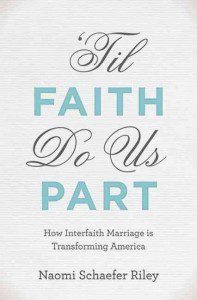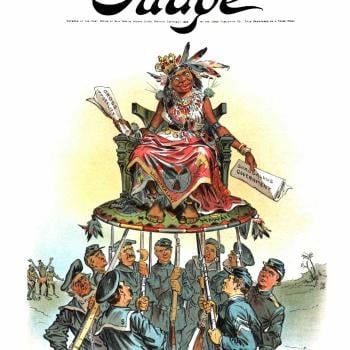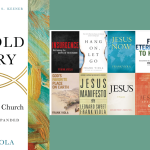Interfaith marriage is skyrocketing in contemporary America. A generation ago, around fifteen percent of Americans married outside their faith, which probably mostly meant Catholics marrying Protestants. Now, according to Naomi Schaefer Riley, the rate is forty-two percent. As Americans continue to delay marriage and drift away from their parents and religious upbringings during their young adulthood, it seems reasonable that soon most Americans will marry outside their religion.
This, according to Riley, has major implications for couples and religious institutions, which she explains in her just-published ‘Til Faith Do Us Part: How Interfaith Marriage is Transforming America. Riley’s book is a very readable blend of survey data (she commissioned a nationwide Interfaith Marriage Survey with the help of the University of Notre Dame’s David Campbell) and anecdotes. She begins with her own. Having grown up in a Conservative Jewish household, she married a man who had left his family’s Jehovah’s Witness faith. They are raising their children Jewish.
While Riley’s own experiences seem to be mostly positive, ‘Til Death Do Us Part is a cautionary tale. For couples, those from separate faith traditions are less likely to find satisfaction in their marriages and more likely to divorce. This is much more true of certain interfaith marriage combinations than others. For Catholics and mainline Protestants, there is not much of a statistical difference between same-faith and interfaith marriages. By contrast, an evangelical Protestant is much more likely to divorce a future spouse if that spouse is not an evangelical. Similarly, her survey data “found that same-faith couples are [modestly but statistically significantly] more satisfied than interfaith ones.” Again, there is significant variance among different sorts of interfaith marriages, and rates of marital satisfaction are particularly high for couples within religiously very active families.
One can readily imagine the reasons for this: stress between couples and their parents/in-laws, arguments about the religious upbringing of children (a topic that seemed hypothetical at the time of the marriage), and the fact that a certain percentage of largely unobservant young adults become more active after a decade or two of marriage.
It’s worth noting that in this study, a union between a non-denominational evangelical Protestant and a mainline Protestant counts as an interfaith marriage. This makes theological sense, but such marriages probably do not fit most Americans’ conceptions of interfaith marriage. This also explains — but only part — why she finds much higher rates of interfaith marriage than in some earlier surveys. However, even within groups with historically low rates of intermarriage, it is increasing rapidly.
For religious institutions, interfaith marriage has rather devastating consequences. The children of these marriages are “less likely to be observant members of their faiths.” Churches and synagogues have been hoping that inactive young adults will return to their childhood faiths after they begin having children. Riley’s book suggests that churches stand to lose many of those young adults permanently.
The news isn’t all bad, of course. Our larger society benefits in important ways from intermarriage, which promotes assimilation and religious tolerance. Protestant parents whose daughter marries a Mormon might initially express strong disapproval. Nevertheless, they are likely to develop warmer feelings not only for their son-in-law but for his church. Interfaith couples also grow in their capacity to more honestly negotiate the pluralistic society in which they live: “interfaith marriage may awaken people to the fact that religions are not all the same, that the particulars of practice and belief do matter, and that not all interfaith conflicts can be solved with the placement of a menorah next to a manger.”
Still, there’s great cause for concern here. Indeed, one would think that given such data, religious leaders across the board would be crusading against intermarriage. Some do. Riley documents the Mormon emphasis on endogamy and introduces both Orthodox Jewish and evangelical leaders who have made in-group marriage their causes. Still, especially outside of Mormon and evangelical circles, most rabbis and ministers offer relatively little resistance to a trend that directly imperils their futures. Parents, moreover, are loathe to alienate their children and future spouses and feel rather helpful to interfere with their children’s quest (often delayed by career aspirations encouraged by those same parents) to find their soulmate irrespective of that mate’s religion or lack thereof.
For the most part, Riley’s book is descriptive rather than prescriptive, but she does offer suggestions to both young lovers (very unlikely to take this book’s concerns seriously) and religious leaders. She could have subtitled her book What Jews (and other Americans) Could Learn from Mormons. Mormons, it turns out, rarely marry non-Mormons, in large part because of the church’s doctrine of celestial marriage. For those couples sealed in temples (only available if both spouses are members in good standing), marriage is for eternity. Nevertheless, when a member marries outside the faith, the Church of Jesus Christ of Latter-day Saints does a remarkably good job of both welcoming and witnessing to those non-member spouses. Thus, those mixed-faith marriages tend to have relatively high rates of satisfaction, and a sizeable percentage of those spouses eventually convert. It’s not always peaches and cream; Riley provides some examples of significant tension between Mormon and non-Mormon spouses. On balance, however, Riley suggests that the Latter-day Saints are handling this issue relatively well. I would surmise that this is far more the case today than it would have been even two or three decades ago.
By contrast, Riley suggests, Reform and Conservative Jewish communities overly fear offending non-Jewish spouses. The very concept of a covenanted people bound not only by personal choice but by a shared history and ancestry also militates against the goal of conversion. Other religious groups would do well to mirror the Latter-day Saint ability to persistently welcome outsiders while attempting to offer their young people compelling reasons to remain active in their faith.
In a broader sense, Riley reminds Americans that religion matters for marriage, at least as much as other factors such as race or political persuasion. After all, rates of marital success and satisfaction correlate to two people having much in common. In a culture that exalts romantic love above nearly anything, regards an emphasis on endogamy as clannish bigotry, and believes that nearly everyone shares the same basic values of helping others and living good lives, it it is difficult for either parents or religious leaders tobuck the trend toward interfaith marriage.












